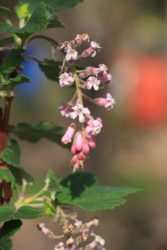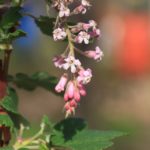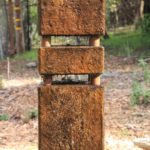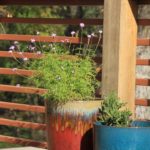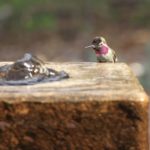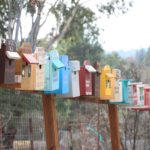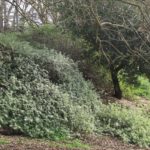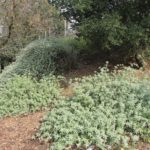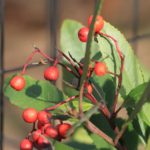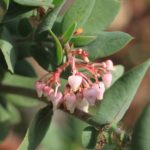Lot size: 1,500 sq. ft. front garden, 1,000 sq. ft. side garden, 85% native
Garden Age: Keystone species—our own, local ecological powerhouse plants— in this garden include valley and coast live oaks, currants, sages and buckwheats (eight kinds), manzanita (five types), California lilac (four varieties), coyote brush, and penstemon.
Years on the Bringing Back the Natives Garden Tour: New this year!
Showcase Feature
Long-time Tour goer Lainie was ready for a change. Despite the difficulties she has experienced gardening on her lot—exposed, hot areas; dry slopes in baking sun; and browsing by deer—she has gone all-out in order to create a welcoming environment for birds and other wildlife. And, she’s on the right track, as oak titmice, Western bluebirds, nuthatches, and screech owls have all nested in the garden, deer and turkey wander through daily to drink, forage, and cool off in the shade, and fawns are an annual delight as they often are discovered hiding in the garden in the early spring.
The new garden was designed to contain year-round flowers and fruit; several fountains and birdbaths provide the water birds need. Birds—and people—love the sound of water falling through the tall, burbling fountain near the deck. Hummingbirds sip from and bathe in this fountain; Lainie has seen woodpeckers clinging to its side to drink. Take a seat on the deck, and enjoy this peaceful garden.
Other Garden Attractions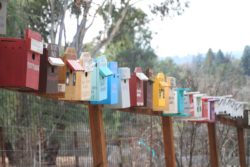
• Roughly fifty bird-houses, hand-made by Lainie, beckon to avian visitors, inviting them to raise their chicks in this welcoming environment, and creating a fun entryway to the garden.
• 265-gallon plastic totes are used to collect rainwater from the roof, allowing about 1,000 gallons of stored water to irrigate the garden.
• Check out the orchard, with its thirty-six varieties of fruit trees, including many heirloom varieties, such as Independence nectarine (1800s), Ananas Reinette apple (France 1800s), Rio Oso Gem Peach (CA 1926), Antonovka apple (Russia 1826), Magnum Bonum apple (1828), Governor Wood Cherry (1842), Egremont Russet apple (England, 1870s), Pink Sparkle apple (1900s), Ashmead’s Kernel apple (England 1700s), and White Pearmain Apple (England, 1200s).
• To control weeds and save water, Lainie has woodchips delivered (free from arborists!) and piles them about 12″ deep throughout the gardened areas and around the plants; watch your step, as they are a soft and uneven surface.
• Deer fencing protects part of the garden; outside the fence are the plants that the deer don’t eat (think sages).
• A $750 lawn conversation rebate from the East Bay Municipal Utility District helped pay for the transformation.
Gardening for Wildlife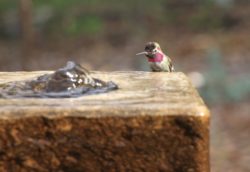
Mature oaks, the plethora of native plants Lainie has planted, and several water sources have brought in oak titmice, nuthatches, Western bluebirds, and woodpeckers. Western fence lizards bask in the sun (when not snacking on insects), skinks are occasionally spotted, and garter snakes and fox pass through. Native bees, butterflies, and other insects are common sights.
Keystone species (watch this talk by Doug Tallamy!)
Keystone species—our own, local ecological powerhouse plants— in this garden include valley and coast live oaks, currants, sages and buckwheats (eight kinds), manzanita (five types), California lilac (four varieties), coyote brush, and penstemon.
At least partially wheelchair accessible? No.


